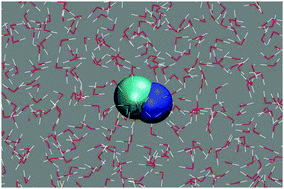Hydration free energies of cyanide and hydroxide ions from molecular dynamics simulations with accurate force fields
Abstract
The evaluation of hydration free energies is a sensitive test to assess force fields used in atomistic simulations. We showed recently that the vibrational relaxation times, 1D- and 2D-infrared spectroscopies for CN− in water can be quantitatively described from molecular dynamics (MD) simulations with multipolar force fields and slightly enlarged van der Waals radii for the C- and N-atoms. To validate such an approach, the present work investigates the solvation free energy of cyanide in water using MD simulations with accurate multipolar electrostatics. It is found that larger van der Waals radii are indeed necessary to obtain results close to the experimental values when a multipolar force field is used. For CN−, the van der Waals ranges refined in our previous work yield hydration free energy between −72.0 and −77.2 kcal mol−1, which is in excellent agreement with the experimental data. In addition to the cyanide ion, we also study the hydroxide ion to show that the method used here is readily applicable to similar systems. Hydration free energies are found to sensitively depend on the intermolecular interactions, while bonded interactions are less important, as expected. We also investigate in the present work the possibility of applying the multipolar force field in scoring trajectories generated using computationally inexpensive methods, which should be useful in broader parametrization studies with reduced computational resources, as scoring is much faster than the generation of the trajectories.


 Please wait while we load your content...
Please wait while we load your content...